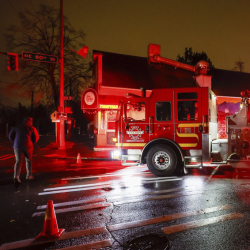 LOS ANGELES -- Krystal Murphy received her first cellphone at age 13 and she used it solely to keep her parents in the loop about her activities. Four years later, her use of the phone has changed dramatically. Now 17, she relies on it to text friends, surf the Internet and send messages on Twitter. LOS ANGELES -- Krystal Murphy received her first cellphone at age 13 and she used it solely to keep her parents in the loop about her activities. Four years later, her use of the phone has changed dramatically. Now 17, she relies on it to text friends, surf the Internet and send messages on Twitter."I'm on my cell all day, every day, as soon as I wake up and until I go to bed," says the African-American teen from South Los Angeles. The Northwestern University study "Children, Media and Race: Media Use Among White, Black, Hispanic, and Asian American Children" found that minorities between ages 8 and 18 use cellphones, television, computers and other electronic devices to consume an average of 13 hours of media content daily. That's 4.5 hours more than their White counterparts. The study has renewed debate about whether minority youths spend too much time on media consumption and not enough on reading and studying. While some people insist that the disparity in media consumption contributes to the education gap between minority and white youths, others cite it as a positive that can aid a child's educational growth. "I think that the results of this study coupled with the other factors that we know influence student performance," says Sharon Lewis, research director for the Council of the Great City Schools, an advocate for urban public schools and students. "When you combine all of this together, it's another indication that we need to take extra steps to reach [minority] youth. "Factors such as health, such as preschool experience, such as a sibling that may not have graduated, such as coming from a single-parent household and then you add this [media consumption] to it—it's another indication." Past reports have shown a correlation between television viewing and low academic performance. A 20-year study of 678 families released in 2007 by the New York State Psychiatric Institute found that teens who watched three or more hours of television daily had an 82 percent greater chance of not graduating from high school when compared with those who watched less than an hour. However, critics of that study say students who struggle academically may be more inclined to watch TV to avoid the rigors of schoolwork. The Northwestern study is said to be the first in the United States to examine children's media use by race. Nearly 1,900 youths participated. The study re-analyzed data from previous Kaiser Family Foundation studies on media consumption, finding that racial differences in children's media use remained static when accounting for socioeconomic status or whether youths came from single- or two-parent homes. The results, which appeared to counter concerns about a possible digital divide and may give parents and educators new strategies to meet needs of minority youths, surprised Ellen Wartella, head of Northwestern's Center on Media and Human Development. She co-authored the study. "Recreational media use is an enormous part of young people's lives, more than we ever thought," she says. "It's quite clear we have a group of young people who are tethered to their technology." The report finds that Black and Latino youths spend one to two more hours daily watching TV and videos, an hour more listening to music, up to 90 minutes more on computers and 90 minutes on cellphones, and 30 to 40 minutes more playing video games than white youths. During the past decade, Black youths have doubled their daily media use, and Latino youths have quadrupled theirs, according to Wartella. Asian-American youths also consume more media than their white peers. Asians lead all groups in use of mobile devices at 3 hours and 7 minutes daily, compared with 2 hours and 53 minutes for Latinos, 2 hours and 52 minutes for Blacks and just 80 minutes for Whites. Asians also spend 14 more minutes daily watching traditional TV than do white youths and more than an hour daily than whites watching TV online, via TiVo or on DVD. Nevertheless, Asian-American youths remain high academic achievers, challenging the contention that media consumption hurts student performance. Kerry Riley, an affiliated scholar at the Ralph J. Bunche Center for African American Studies at the University of California, Los Angeles, says media can help students of color in the classroom. "For me, the issue isn't having more media," says the professor of ethnic studies. "It's access to higher standards of media." He adds that teachers and mentors of minority youths increasingly expose them to social networking sites such as Twitter and Facebook to help them learn about many issues. Riley says he has directed students to use cellphones in class to access music videos and shown them cartoons such as "South Park" and "Family Guy." Incorporating media in class to showcase popular culture, he says, has helped Blacks and Latinos understand how music forms and television shows can function as parodies of Western society. "We helped them to understand these weren't just elements of popular culture," Riley says. "They were existential forms of social critique that related directly to their lives. So I, as an African-American professor, was able to use popular culture via Google, YouTube, Twitter, Facebook as a pedagogical tool to help educate African-American and Latino youth and increase their academic performance." Northwestern's Wartella agrees that greater media consumption isn't necessarily a drawback for youths but might put them at risk for obesity. "One concern is exposure to food marketing, specifically television advertising for foods high in calories and lower in nutrients," she says. "We're saying maybe we should take a look at the negative consequences if they're watching television. Our hope is to start a national conversation about youth and media." Her study's finding that, among children, 84 percent of blacks, 77 percent of Hispanics and 64 percent of Whites and Asian-Americans have TV sets in their rooms is telling. Blacks not only lead youths in TV ownership but also are also more likely to be obese or overweight. The U.S. Department of Health and Human Services estimates that 22.4 percent of Black children are obese and 44.4 percent are overweight, compared with 17.4 percent and 36.9 percent for white children, respectively. Félix Gutiérrez, a University of Southern California journalism and communication professor who has written extensively about race and media, doesn't necessarily recommend advising youths of color to watch less television. It depends on whether they're intellectually engaged, he says. The New York State Psychiatric Institute study found that students who passively absorb entertainment on television find classroom lessons boring. Gutiérrez advises parents that rather than leaving children alone to watch favorite shows, they should join them and initiate meaningful discussion about what's on the screen. "Studies in the past have shown that when children saw a stereotypical portrayal of an Indian or black or Mexican, it helped to have parents there to challenge the message," he says. "There weren't many Latinos on TV, so if a Ricky Ricardo type came on, the child could hear the parent saying, 'People think we're all like that.' " Such critical feedback from parents helps children of color not to internalize racially demeaning messages, according to Gutiérrez. Of course, not all minority youths spend much time watching television. Melissa Reed, 15, of the San Fernando Valley in California, says she rarely tunes in. Instead, the Black teen exercises regularly and spends "maybe like up to five hours listening to music on my iPod." Melissa also spends about an hour daily on her computer but not necessarily for homework. The Northwestern study found this trend among youths of all races. White, Black and Hispanic juveniles spend on average of 16 minutes daily on computers for studies, with Asian-Americans using computers for that purpose a mere four minutes more. That the Northwestern report showed little difference in numbers of computers in homes of white, black and Latino children surprised Gutiérrez. Homes of each of these groups have about two computers, while Asian-American homes average three. "This runs counter to the digital divide talk of the late '90s and early part of the millennium when they said that Black and Latino youth would be left behind technologically," Gutiérrez says. Now that minority youths rely daily on new and traditional media, parents and educators should engage them by using these tools, says Lewis of the Council of the Great City Schools. "Educators need to be more familiar with this new media, so we can use this to our advantage, so young people can have an educational experience with it that's meaningful." Krystal and Melissa say teachers routinely assign them homework requiring Internet use and that taking shortcuts that way is all too easy. According to Melissa, students must be motivated to use technology to develop better thinking skills. "I think the Internet can easily give you answers if you use it just to look up answers for homework, but it doesn't really help," she says. "That's the easy way out. If you actually want to learn, that's not going to help at all." Parents can help by monitoring how children use different forms of media and for what length of time, Lewis says. The worst thing parents can do is allow children to shut themselves in their rooms while using media because that offers no way to gauge whether critical thinking skills are being used, she says. Wartella agrees. She says media shouldn't function as baby sitters but should entertain and inform youngsters, and connect them with parents. "Parents should start talking to young people about what media they're using and why they're using it and try to figure out what's going on," she says. "It's the way we communicate with our children." (America's Wire is an independent, non-profit news service run by the Maynard Institute for Journalism Education. America's Wire is made possible by a grant from the W. K. Kellogg Foundation. For more information, visit www.americaswire.org or contact Michael K. Frisby at [email protected].) |
Portland and Seattle
Free Subscription to Breaking News
Free Subscription to Breaking News






















































































































































































































































































































































